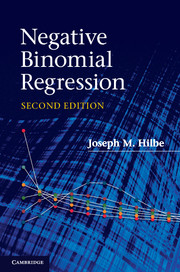Book contents
- Frontmatter
- Contents
- Preface to the second edition
- 1 Introduction
- 2 The concept of risk
- 3 Overview of count response models
- 4 Methods of estimation
- 5 Assessment of count models
- 6 Poisson regression
- 7 Overdispersion
- 8 Negative binomial regression
- 9 Negative binomial regression: modeling
- 10 Alternative variance parameterizations
- 11 Problems with zero counts
- 12 Censored and truncated count models
- 13 Handling endogeneity and latent class models
- 14 Count panel models
- 15 Bayesian negative binomial models
- Appendix A Constructing and interpreting interaction terms
- Appendix B Data sets, commands, functions
- References and further reading
- Index
8 - Negative binomial regression
Published online by Cambridge University Press: 05 June 2012
- Frontmatter
- Contents
- Preface to the second edition
- 1 Introduction
- 2 The concept of risk
- 3 Overview of count response models
- 4 Methods of estimation
- 5 Assessment of count models
- 6 Poisson regression
- 7 Overdispersion
- 8 Negative binomial regression
- 9 Negative binomial regression: modeling
- 10 Alternative variance parameterizations
- 11 Problems with zero counts
- 12 Censored and truncated count models
- 13 Handling endogeneity and latent class models
- 14 Count panel models
- 15 Bayesian negative binomial models
- Appendix A Constructing and interpreting interaction terms
- Appendix B Data sets, commands, functions
- References and further reading
- Index
Summary
In this and subsequent chapters we shall discuss the nature and utility of some 25 varieties of negative binomial regression that are useful for modeling count response data. In addition, we examine certain models that are related to the negative binomial family of models. This chapter will primarily be devoted to an examination of the derivation of the negative binomial model and to the two foremost methods of its estimation. We also consider how the probabilities generated from a negative binomial model differ from the Poisson, as well as how they differ among various negative binomial models based on both mean and ancillary parameters.
Varieties of negative binomial
I mentioned that the basic negative binomial model can be enhanced to allow for the modeling of a wide range of count response situations. The Poisson can likewise be enhanced to adjust for data that violate its essential distributional assumptions. In fact, many of the same distributional problems face both Poisson and negative binomial models. We therefore find similar approaches to the handling of such data for both the Poisson and negative binomial. These include models such as zero-inflated Poisson (ZIP), which is directly related to the zero-inflated negative binomial (ZINB). All of the models allow for an estimated variance that exceeds the mean – the principal assumption of the Poisson regression model being that of equidispersion.
- Type
- Chapter
- Information
- Negative Binomial Regression , pp. 185 - 220Publisher: Cambridge University PressPrint publication year: 2011
- 5
- Cited by



